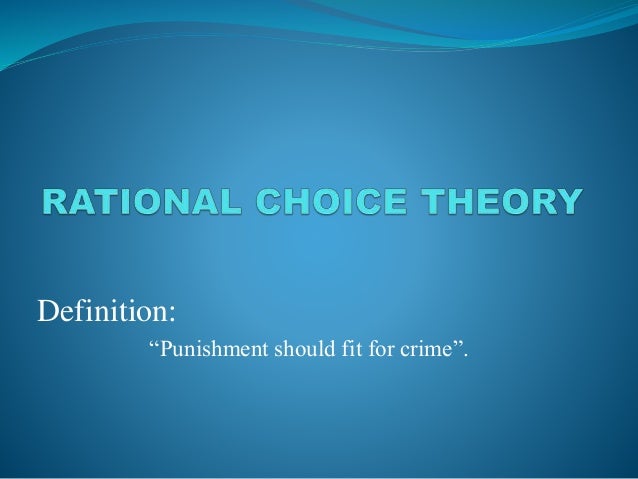Have you ever wondered why people commit crimes? What drives someone to steal, vandalize, or even commit violent acts? While the reasons behind criminal behavior are complex and multifaceted, one influential theory attempts to explain it through the lens of rational decision-making: Rational Choice Theory. This approach, deeply ingrained in criminology, argues that individuals choose to engage in crime when the perceived benefits outweigh the potential costs.

Image: criminologyweb.com
Understanding the core principles of Rational Choice Theory can shed light on why and how people commit crimes, providing a framework for developing effective crime prevention strategies. This article will delve into the history, key concepts, and practical implications of this theory, highlighting its strengths and limitations within the context of criminology.
The Origins and Evolution of Rational Choice Theory
From Classical Criminology to Modern Applications
The roots of Rational Choice Theory can be traced back to the Enlightenment period, where philosophers like Cesare Beccaria and Jeremy Bentham emphasized the importance of free will and rationality in human behavior. They believed that individuals, driven by self-interest, would weigh the potential consequences of their actions before committing a crime. This approach, known as Classical Criminology, laid the groundwork for the development of modern rational choice theory.
In the 20th century, economists Gary Becker and James Q. Wilson provided a more contemporary perspective on Rational Choice Theory, integrating economic principles into the study of crime. They argued that individuals rationally weigh the expected costs and benefits of criminal activity, similar to how they make economic decisions. This expanded view, coupled with advances in criminological research, led to the widespread adoption of Rational Choice Theory as a framework for understanding criminal motivations.
Key Concepts of Rational Choice Theory

Image: www.slideshare.net
The Cost-Benefit Analysis: A Central Principle
Central to Rational Choice Theory is the idea that individuals make decisions based on a rational cost-benefit analysis. This means that they consider the potential rewards of committing a crime (such as financial gain, status, or revenge) and weigh them against the perceived risks (such as punishment, social stigma, or injury). This process can be simplified using a cost-benefit matrix:
- Benefits: Financial gain, status enhancement, emotional satisfaction, revenge.
- Costs: Legal penalties, social stigma, physical harm, financial losses, opportunity costs.
The theory postulates that individuals will choose to engage in crime if the perceived benefits exceed the perceived costs. For example, a shoplifter might rationalize stealing a small item because the potential reward (the item itself) outweighs the risk of being caught and punished.
Individual Factors and Situational Influences
While the core of Rational Choice Theory focuses on rational decision-making, it also acknowledges the influence of individual and situational factors. These factors can significantly impact the cost-benefit equation, influencing a person’s decision to engage in criminal behavior. Here are some examples:
- Personal Traits: Factors like age, gender, education level, criminal history, and personality can influence an individual’s risk tolerance and propensity for criminal activity.
- Social Context: The social environment, including factors such as poverty, lack of opportunities, peer pressure, and social norms, can create conditions that may incentivize individuals towards criminal behavior.
- Situational Circumstances: The immediate context of a crime, including factors such as the availability of targets, security measures, and the presence of law enforcement, can influence the perceived risks and benefits of committing a crime.
Critiques and Limitations of Rational Choice Theory:
Not All Choices Are Perfectly Rational
While Rational Choice Theory offers a valuable framework for understanding criminal behavior, it’s important to recognize its limitations. Not all criminal behavior is necessarily driven by rational calculation. Emotion, impulsivity, and lack of self-control can play significant roles in decision-making, particularly in cases of violent crime or crimes committed under the influence of drugs or alcohol.
Furthermore, the theory struggles to explain crimes driven by mental illness or extreme emotional states. Individuals with mental disorders may lack the capacity for rational decision-making, making their actions less readily explained by this theoretical framework.
The Importance of Context
Another critique is that Rational Choice Theory can be overly simplistic in its portrayal of crime. It doesn’t always adequately account for the complex social, economic, and environmental factors that contribute to criminal behavior. For example, while the theory acknowledges situational influences, it may not fully capture the systemic factors that limit opportunities and contribute to the cycle of poverty, which can influence individuals towards criminal activity.
The Role of Deterrence in Crime Prevention
Despite its limitations, Rational Choice Theory has had a significant impact on crime prevention policies. The theory’s focus on individual choice and cost-benefit analysis has led to a greater emphasis on deterrence strategies, such as increasing the severity of punishments, improving law enforcement effectiveness, and enhancing surveillance systems.
While deterrence can be an effective crime prevention strategy, it’s important to acknowledge its limitations. Studies have shown that harsh punishments alone are not always effective in deterring crime, and that other factors, such as social rehabilitation and economic opportunities, play critical roles in reducing crime rates.
Rational Choice Theory and Contemporary Criminology
Rational Choice Theory’s influence on contemporary criminology is undeniable. It remains a widely studied and debated theory, with researchers constantly exploring its applications and limitations. Ongoing research strives to incorporate the theory’s strengths while addressing its weaknesses, leading to a more nuanced understanding of criminal behavior and improved crime prevention strategies.
Emerging Applications:
Recent research explores the application of Rational Choice Theory in areas such as:
- Cybercrime: Investigators use the theory to understand the motivations, means, and risk assessments of cybercriminals in order to develop effective countermeasures.
- Terrorism: Researchers utilize the theory to analyze the decisions and motivations of terrorist groups, helping to predict and prevent future attacks.
- Organized Crime: By applying the theory’s principles, researchers can understand the structure, dynamics, and risk-reward calculations of criminal organizations.
Rational Choice Theory Definition Criminology
Conclusion: Illuminating Criminal Behavior Through Reason
Rational Choice Theory offers a valuable framework for understanding criminal behavior as a result of rational decision-making. By considering the perceived benefits and consequences of criminal activity, we gain insight into why individuals may choose to commit crimes. The theory’s emphasis on deterrence has significantly impacted crime prevention policies, though its limitations remind us that criminal behavior is complex and can be influenced by a wide array of factors beyond simply rational calculation.
As we continue to learn more about the intricate workings of the human mind and the social forces shaping criminal behavior, Rational Choice Theory will likely continue to evolve and adapt. Its ongoing exploration and application will contribute to a better understanding of crime and more effective crime prevention strategies in the future.






